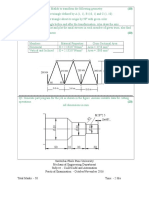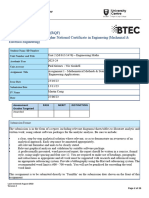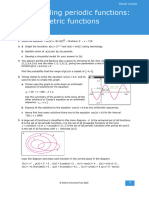Answer Script
Uploaded by
Maria KapiyaAnswer Script
Uploaded by
Maria Kapiya4+
National Institute of Technology
We seek to create and develop Vibrant, Skilled, Competent and Work-prepared Entrepreneurial Technicians, Technologists and
Professionals for the industry and the national economic vitality.
School of Applied Engineering,
Innovation, and Technology
Diploma in Mechanical/Electrical & Electronic
Engineering (Level 5)
Main Assignment
(Marking Scheme)
2ME201/2EEE201
Calculus for Engineering
[Marking Scheme]
Due Date: 31st May 2024
Total Marks: 100
Assessor: Devens Shiningeni Moderator:
Instructions to Students
1. Answers must be typed (font size 12, Arial).
2. Assignments submitted after the deadline will NOT be marked.
3. Plagiarism is a serious offence and can disqualify your assignment.
4. Assignments and Projects are subject to be checked through TURNITIN for
plagiarism verification.
Task 1
You are a city planner tasked with analysing traffic flow along a major arterial road.
You have collected data on the number of vehicles passing through a particular
intersection over time. The data suggests that the rate of change of traffic flow can be
modelled by the function T(t) = 200 + 30t − 0.5t 2, where T(t) represents the number
of vehicles passing through the intersection per minute at time t in minutes.
a. Calculate the rate of change of traffic flow with respect to time when t = 10 minutes.
[5 Marks]
b. Utilize your city's traffic data visualization tool, to graph the function T(t) over time,
indicating the point (10, T(10)). [ 10 Marks]
c. From the graph in part (b), draw a tangent line to the curve at the point (10, T(10)).
Determine the gradient of the function at this point and interpret its meaning in the
context of traffic flow. [5 Marks]
Task 2
You are a mechanical engineer tasked with designing a hydraulic system for a heavy-
duty construction vehicle. Your goal is to optimize the hydraulic flow rates to ensure
efficient operation and maximum performance.
a. Consider the hydraulic flow rate function;
200𝑡 2
𝑄 (𝑡) = .
√𝑡+𝑒 0.1𝑡
Substitute the value t = 5 into the expression for Q′(t) to determine the
instantaneous gradient at t = 5. Interpret the result in the context of hydraulic flow
in the system. [3 Marks]
b. Derive the analytical expression for Q′(t) and plot the function Q(t) on a graph. Use
the graph to estimate the gradient at specific points and compare the values
obtained analytically and graphically. Analyze any discrepancies and discuss
potential sources of error. [15 Marks]
Task 3
Consider the function f(x) = x3 − 5x2 + 2x + 6, which represents the cost function for a
production process. Plot the graph of f(x) and identify the maximum and minimum
turning points. Discuss how these turning points relate to cost optimization in
manufacturing operations. [15 Marks]
2ME201/2EEE201 Calculus for Engineering 2|Page
Task 4
A chemical engineering company is designing a new heat exchanger for a
petrochemical plant. The rate of heat transfer through the heat exchanger can be
modeled by the function Q(t) = 4t2 − 6t + 10 kW, where t represents the time in hours.
To determine the total heat transferred over a certain time period, the engineers need
to integrate this function. [15 Marks]
Given the heat transfer function Q(t), perform the following tasks:
a. Calculate the total heat transferred from t= 0 to t = 4 hours using definite integration.
b. Determine the rate of change of heat transfer with respect to time t by finding the
derivative of Q(t).
c. Determine the maximum and minimum points of the rate of heat transfer and
discuss their implications for the efficiency of the heat exchanger.
Task 5
An engineering firm is designing a hydraulic system for a construction project. The
hydraulic system exerts a variable force F(x) = 3x2 − 2x + 5 kN over a distance x
meters. To determine the total work done by the hydraulic system, engineers need to
calculate the area under the force-displacement curve. [10 Marks]
Given the force-displacement function F(x), perform the following tasks:
a. Calculate the work done by the hydraulic system over the displacement range
x = 0 to x = 4 meters using the strip theory
(approximate area of the elemental strip = F(x) δx ).
b. Determine the mean value of the force F(x) over the displacement range x = 0 to
x = 4 meters.
2ME201/2EEE201 Calculus for Engineering 3|Page
Task 6
A mechanical engineering company is analysing the stress distribution along a beam
subjected to varying loads. The stress distribution can be represented by the function
σ(x) = 3x2 − 2x + 5 MPa over the length of the beam. The engineers need to calculate the total
stress on the beam using numerical integration methods.
Given the stress distribution function σ(x), perform the following tasks:
a. Use the Trapezoidal Rule, Mid-ordinate Rule, and Simpson's Rule to calculate the total
stress on the beam over the length x = 0 to x = 5 meters. Compare the results obtained
from each method in terms of their complexity and accuracy. [15 Marks]
b. Integrate the stress distribution function σ(x) analytically to obtain the exact total stress on
the beam. Compare this value with the results obtained using Simpson's Rule. [2 Marks]
c. Implement numerical integration using a spreadsheet (e.g., Excel or Google Sheets) to
calculate the total stress on the beam over the length x = 0 to x = 5 meters using Simpson's
Rule. [5 Marks]
Assignment Deliverables
1. Typed Main Assignment (Detailed with all calculations and steps followed)
2. A4 Grid Papers with pencil drawn graphs (Graphs with written task numbers and
are well labelled).
3. Excel Spreadsheet
TOTAL MARKS = 100
<<<GOOD LUCK>>>
2ME201/2EEE201 Calculus for Engineering 4|Page
Created with blocklayer.com
You might also like
- Introduction to the simulation of power plants for EBSILON®Professional Version 15From EverandIntroduction to the simulation of power plants for EBSILON®Professional Version 15No ratings yet
- Retreats Ora Grodsky and Jeremy PhillipsNo ratings yetRetreats Ora Grodsky and Jeremy Phillips11 pages
- Mock Exam 22 23 KH6063MAA - Computational - ThermoFluids - 2022 2023No ratings yetMock Exam 22 23 KH6063MAA - Computational - ThermoFluids - 2022 20236 pages
- Written-Report-Machine-Problem-1 - DEL ROSARIO - BSCE 2-5No ratings yetWritten-Report-Machine-Problem-1 - DEL ROSARIO - BSCE 2-59 pages
- Excel Applied to Civil Engineering as a Computational ToolNo ratings yetExcel Applied to Civil Engineering as a Computational Tool18 pages
- Cad Cam Automation Pune University Question PapersNo ratings yetCad Cam Automation Pune University Question Papers8 pages
- Structural Optimization Assignment Final PrintNo ratings yetStructural Optimization Assignment Final Print31 pages
- Matlab Based Simulations of A Three PhasNo ratings yetMatlab Based Simulations of A Three Phas8 pages
- Internal Verification of Assignment BR Iefs: Evaluation Criteria 1 Draft Final BriefNo ratings yetInternal Verification of Assignment BR Iefs: Evaluation Criteria 1 Draft Final Brief12 pages
- University of Zimbabwe: 2018 May/June ExaminationsNo ratings yetUniversity of Zimbabwe: 2018 May/June Examinations4 pages
- Phạm Lê Ngọc Sơn - 2051185 - - DSP - LAB3 - - FINAL100% (1)Phạm Lê Ngọc Sơn - 2051185 - - DSP - LAB3 - - FINAL25 pages
- Capital Investment Practice Class - Solutions Week 8No ratings yetCapital Investment Practice Class - Solutions Week 84 pages
- Scaling Free CORDIC Algorithm Implementation of Sine and Cosine FunctionNo ratings yetScaling Free CORDIC Algorithm Implementation of Sine and Cosine Function4 pages
- Costing, Technological Growth and Generalized Learning Curves (Knetch)No ratings yetCosting, Technological Growth and Generalized Learning Curves (Knetch)6 pages
- Perform Binary Subtraction Using 2's Complement Method 54No ratings yetPerform Binary Subtraction Using 2's Complement Method 541 page
- Faculty of Science and Technology OPENBOOK EXAM: COM 123 Numerical Analysis and ComputationNo ratings yetFaculty of Science and Technology OPENBOOK EXAM: COM 123 Numerical Analysis and Computation5 pages
- University of Mauritius Faculty of Engineering: ProgrammeNo ratings yetUniversity of Mauritius Faculty of Engineering: Programme8 pages
- Examen Simulacro de Control de Manipuladores Robóticos 2No ratings yetExamen Simulacro de Control de Manipuladores Robóticos 22 pages
- How to Design Airports (Airside) By AutoCAD Civil 3D (Runway – Taxiway – Apron)From EverandHow to Design Airports (Airside) By AutoCAD Civil 3D (Runway – Taxiway – Apron)No ratings yet
- AEP611S Lecture Notes Two-Port Networks Semester-1 2024 Revised The Complete DocumentNo ratings yetAEP611S Lecture Notes Two-Port Networks Semester-1 2024 Revised The Complete Document167 pages
- Wind Turbine - Wikipedia, The Free EncyclopediaNo ratings yetWind Turbine - Wikipedia, The Free Encyclopedia17 pages
- Catalog Portable Abrasive Blasting en v9 0 0 WebNo ratings yetCatalog Portable Abrasive Blasting en v9 0 0 Web72 pages
- Choong-Sik Chung - Developing Digital Governance - South Korea As A Global Digital Government Leader-Routledge (2020) - RemovedNo ratings yetChoong-Sik Chung - Developing Digital Governance - South Korea As A Global Digital Government Leader-Routledge (2020) - Removed13 pages
- 14 1 22 Engineering Datasheet Rse75n A13 RevcNo ratings yet14 1 22 Engineering Datasheet Rse75n A13 Revc1 page
- Clinical Teaching On Cardiac RehabilitationNo ratings yetClinical Teaching On Cardiac Rehabilitation14 pages
- Traditional Network Architecture and SDNNo ratings yetTraditional Network Architecture and SDN9 pages
- Computer Technologies Used in An OrganizationNo ratings yetComputer Technologies Used in An Organization7 pages
- Introduction to the simulation of power plants for EBSILON®Professional Version 15From EverandIntroduction to the simulation of power plants for EBSILON®Professional Version 15
- Mock Exam 22 23 KH6063MAA - Computational - ThermoFluids - 2022 2023Mock Exam 22 23 KH6063MAA - Computational - ThermoFluids - 2022 2023
- Written-Report-Machine-Problem-1 - DEL ROSARIO - BSCE 2-5Written-Report-Machine-Problem-1 - DEL ROSARIO - BSCE 2-5
- Excel Applied to Civil Engineering as a Computational ToolExcel Applied to Civil Engineering as a Computational Tool
- Cad Cam Automation Pune University Question PapersCad Cam Automation Pune University Question Papers
- Internal Verification of Assignment BR Iefs: Evaluation Criteria 1 Draft Final BriefInternal Verification of Assignment BR Iefs: Evaluation Criteria 1 Draft Final Brief
- University of Zimbabwe: 2018 May/June ExaminationsUniversity of Zimbabwe: 2018 May/June Examinations
- Phạm Lê Ngọc Sơn - 2051185 - - DSP - LAB3 - - FINALPhạm Lê Ngọc Sơn - 2051185 - - DSP - LAB3 - - FINAL
- Capital Investment Practice Class - Solutions Week 8Capital Investment Practice Class - Solutions Week 8
- Scaling Free CORDIC Algorithm Implementation of Sine and Cosine FunctionScaling Free CORDIC Algorithm Implementation of Sine and Cosine Function
- Costing, Technological Growth and Generalized Learning Curves (Knetch)Costing, Technological Growth and Generalized Learning Curves (Knetch)
- Perform Binary Subtraction Using 2's Complement Method 54Perform Binary Subtraction Using 2's Complement Method 54
- Faculty of Science and Technology OPENBOOK EXAM: COM 123 Numerical Analysis and ComputationFaculty of Science and Technology OPENBOOK EXAM: COM 123 Numerical Analysis and Computation
- University of Mauritius Faculty of Engineering: ProgrammeUniversity of Mauritius Faculty of Engineering: Programme
- Examen Simulacro de Control de Manipuladores Robóticos 2Examen Simulacro de Control de Manipuladores Robóticos 2
- Worked Examples in Mechanical Vibrations using MATLABFrom EverandWorked Examples in Mechanical Vibrations using MATLAB
- How to Design Airports (Airside) By AutoCAD Civil 3D (Runway – Taxiway – Apron)From EverandHow to Design Airports (Airside) By AutoCAD Civil 3D (Runway – Taxiway – Apron)
- AEP611S Lecture Notes Two-Port Networks Semester-1 2024 Revised The Complete DocumentAEP611S Lecture Notes Two-Port Networks Semester-1 2024 Revised The Complete Document
- Choong-Sik Chung - Developing Digital Governance - South Korea As A Global Digital Government Leader-Routledge (2020) - RemovedChoong-Sik Chung - Developing Digital Governance - South Korea As A Global Digital Government Leader-Routledge (2020) - Removed






























































































